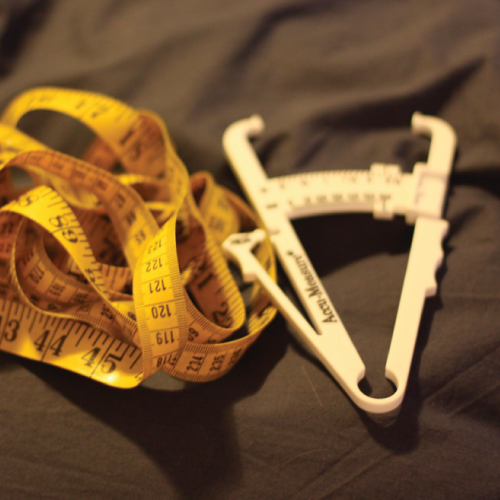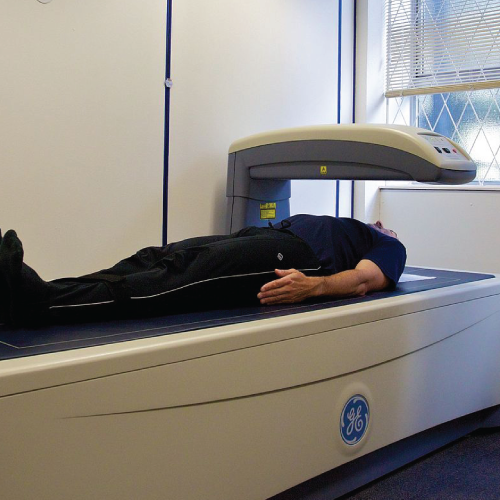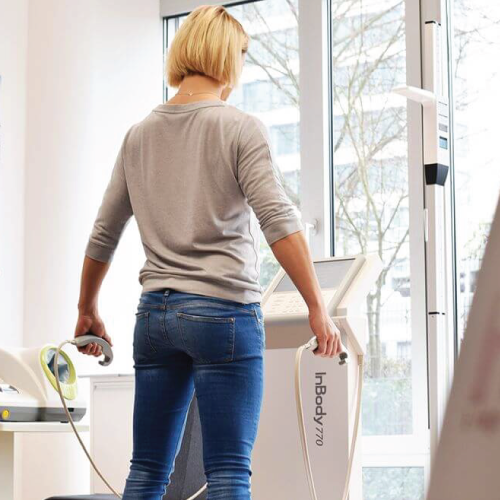WHAT IS BODY COMPOSITION?
Body composition is used by health professionals to evaluate a person’s weight by breaking it down into its core components: fat, protein, minerals, and body water.
It describes your healthy weight more accurately and provides a better glimpse into your overall health than traditional methods like BMI & weight.
Body composition analysis can accurately show changes in fat mass, lean muscle mass, and body fat percentage.
Why Is Body Composition Important To Measure?
Most diet and fitness goals focus on weight loss or gain, overlooking that two people of the same sex and body weight may look completely different from each other because they have different body compositions. Measuring your body composition will tell you your own body’s unique makeup and help you identify areas to work on to improve your overall health and wellness.
Getting a better insight into your overall wellness starts with measuring your body composition and going beyond the number on the scale. You will know whether you need to gain more lean mass or lower body fat percentage to achieve a healthy body composition and a better level of health.

How Can BMI Be Inaccurate and Misleading?
You may not have heard of body composition before, but you’re probably familiar with BMI. What’s the difference? Body Mass Index (BMI) is a popular method used to assess the health of an individual by comparing the amount of weight they carry to their height: BMI – kg/m2
Despite the widespread use of Body Mass Index in clinical practice, BMI has many limitations and is a poor tracking tool for weight change because there’s no way to identify if changes in your weight are in fat or muscle. Predicting health or mortality using a single number such as BMI oversimplifies health and ignores important factors that contribute to optimal health.
When you set out to get healthier, you likely focus on losing fat and gaining muscle. The weight scale and BMI cannot tell you how much of your weight loss is fat, muscle, or body water, but body composition can.
Why Do You Need To Understand Your Weight in Terms of Muscle and Fat Mass?
You may be aware of the healthy weight ranges, but how do you get there? If you only focus on losing weight, you may end up losing muscle mass and eventually sabotage your efforts.
By differentiating between muscle and body fat, body composition removes the guesswork of determining what your weight fluctuations mean, be it muscle gain, body fat loss, or anything in between.
Whatever your goals may be, an important thing to keep in mind during your health journey is there’s more to being healthy than looking thin.

Does Skinny Always Equal Healthy?
Many assume that having as little fat as possible is healthy. However, being thin does not automatically reduce your health risk—“skinny fat” people can carry the same elevated health risks as obese people.
People who are “skinny fat” may look thin and healthy because they have an acceptable amount of subcutaneous fat—the type of fat stored just under the skin—but they have increased health risks due to poor body composition: too much body fat, a high level of visceral fat, and too little muscle mass.
Furthermore, those classified as skinny fat are typically unaware of their potential health risks because visceral fat cannot be measured with BMI and scales, so it goes undetected. Whether you fall into one of the above categories or want to start making healthy changes, understanding your muscle-fat balance is a great place to start.
A healthy balance of fat and muscle is a vital component of long-term health. Having sufficient muscle mass helps bolster the immune system to fight off illnesses, support good posture, enhance mobility, and prevent frailty in old age.

What Are Examples of Body Composition?
Many individuals will fall within one of four different body composition categories below. Knowing your body composition helps you design an effective, personalized fitness and nutrition plan.
1) Balanced Body Composition: This individual’s weight, body fat percentage, and muscle mass are within the same range. A balanced body composition can be healthy or unhealthy depending on your body fat percentage.
2) High Body Fat, Low Muscle Mass: This individual’s weight is considered healthy for their height but they have a high body fat percentage and low muscle mass level.
3) High Muscle Mass, Low Body Fat: This individual’s weight may be considered high for their height using BMI but that is because they have a high muscle mass level. Their body fat percentage may be lower than average.
To learn more about how to understand your body composition results, check out the result sheet interpretation page.
What Are the Benefits of Body Composition?
A healthy body composition contributes to a stronger immune system and reduces your health risk for common chronic diseases and conditions like high blood pressure, cardiovascular disease, and type 2 diabetes.
Here’s how you can use body composition to improve your wellbeing.
How Do You Track Your Progress With Body Composition Outputs?
You can easily track progress and measure the effectiveness of your diet and exercise regimen using body composition.There are several essential body composition outputs that you can use to track your progress over time:
Percent Body Fat (PBF)
Percent Body Fat or Body Fat Percentage is a more accurate indicator of your health than your body weight or BMI because it tells you exactly how much fat mass makes up your total body weight.
For a healthy body fat level, aim for a PBF within 10 – 20% (for males) or 18 – 28% (for females).
Skeletal Muscle Mass (SMM)
Skeletal Muscle Mass is crucial for mobility, posture, and strong immunity for long-term health. Body composition analysis shows you precisely how much Skeletal Muscle Mass you have in each body segment, so you can focus on building more muscle or correct imbalances to ensure you have a healthy muscle mass balance.
Body Water (TBW)
Your Total Body Water (TBW) is divided into two groups: extracellular water (ECW), which is the water outside your cells, and intracellular water (ICW), which is the water within your cells. A healthy balance of body water is critical for good health. With body composition analysis, you can identify any changes and address them to maintain a healthy balance.
Methods of Body Composition Analysis
There are many ways to determine your body composition. Some are quick and easy but only provide basic information. Some are time-consuming and expensive and require the assistance of a trained technician to administer a test. Here are a few popular body composition methods:

Skin Calipers
One of the anthropometric methods used for measuring body fat is the skinfold test. It is also known as pinch test. As the name implies, this method involves pinching the subcutaneous fat layer with fingers and measuring the thickness using a caliper. Calipers easily portable, and measurement is simple and inexpensive. However, this method involves estimating the total Percent Body Fat (PBF) based on subcutaneous fat.
Although a large portion of body fat is subcutaneous fat, the measurement may not be accurate for people whose body fat distributions vary. Also, measurement is difficult if the subcutaneous fat layer thickness is 5 cm or more and reproducibility of the result varies greatly depending on the skills of the measurer.

Hydrostatic Weighing
Hydrostatic Weighing Underwater weighing calculates the total body fat by the density of the body. It is based on Archimedes’ principle: when an object is submerged in water, the difference between the mass of the object in the air and its mass in water is the object’s volume.
Body density = Mass of air /(Mass of air – Mass of water)
Image Credit: Texas A
Underwater weighing is regarded as the gold standard for body composition measurement as it is one of the only body composition technologies that have been compared directly to cadaver analysis.

Air Displacement Plethysmography
This method measures the volume of a human body by measuring the volume of air according to the changes in pressure in a chamber.
First, weight and volume of the person are used to calculate body density and then Percent Body Fat and the fat-free ratio.
Density = Mass / Volume
Percent Body Fat = (495 / Density) – 450
Fat-free ratio = 100 – BF%
Time required for measurement is relatively short at 3-5 minutes and the examinee can continue breathing in the chamber as opposed to underwater weighing. This method is known as a gold standard because it allows body composition analysis and produces accurate measurements using volume just like underwater weighing.
Image Credit: U.S. Air Force photo by Joel Martinez

Dual Energy X-Ray Absorptiometry (DEXA)
DEXA is an imaging method that measures the body weight in terms of BMC, lean, and fat based on the decrement of X-ray on the images obtained by exposing to two different X-rays. With the patient lying down, photons of the X-ray beams of different energy levels scan the patient. It takes about 5 to 30 minutes.
As a standard method for body composition analysis, DEXA has high accuracy along with hydrodensitometry. Its advantage is that it can measure the body composition of bone density, body fat and muscle mass for different parts. Advancements to the technology affords DEXA the ability to differentiate lean and fat, allowing this technology to advance from a 2 compartment model to a 3 compartment model.
In order to get a DEXA scan performed, you will typically need to make an appointment with a hospital or clinic that has a DEXA device. You may need to do some research; not all hospitals and clinics will have DEXA devices.
Image Credit: Wikipedia

MRI (Magnetic Resonance Imaging)
Magnetic resonance is a form of imaging technique where the body water may be mapped (but not quantified). The body is scanned in segmental (slices) scans are used to predict whole-body values. MRI is considered to be the most accurate tool for in vivo quantification of body composition. It is an ideal evaluation tool for measurement of skeletal muscle mass and adipose tissue (and can divide adipose into visceral and subcutaneous depots).
Image Credit: Northwest Radiology
MRI’s use a high-strength magnet, thus all metal must be removed. Individuals with metallic chips, materials, surgical clips, artificial joints/prosthetics, pacemakers, metal implants, artificial heart valves, metallic cochlear implants, bullet fragments, or insulin pumps should not test. However, since there is no ionizing radiation, this is a preferable option for many (elderly, children, etc.)
A whole-body scan is roughly 25-30min for scan and 3 hours to analyze via computer software.

Dual Energy X-Ray Absorptiometry (DEXA)
DEXA is an imaging method that measures the body weight in terms of BMC, lean, and fat based on the decrement of X-ray on the images obtained by exposing to two different X-rays. With the patient lying down, photons of the X-ray beams of different energy levels scan the patient. It takes about 5 to 30 minutes.
As a standard method for body composition analysis, DEXA has high accuracy along with hydrodensitometry. Its advantage is that it can measure the body composition of bone density, body fat and muscle mass for different parts. Advancements to the technology affords DEXA the ability to differentiate lean and fat, allowing this technology to advance from a 2 compartment model to a 3 compartment model.
In order to get a DEXA scan performed, you will typically need to make an appointment with a hospital or clinic that has a DEXA device. You may need to do some research; not all hospitals and clinics will have DEXA devices.
Image Credit: Wikipedia
How to Improve Your Body Composition
The goal for most people is to decrease body fat and increase muscle mass. Most people know that we should focus on proper nutrition and exercise. The challenge is where to begin. Here are your first steps:
